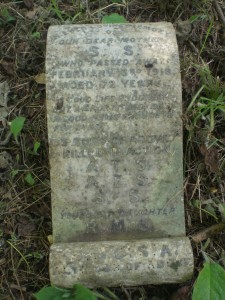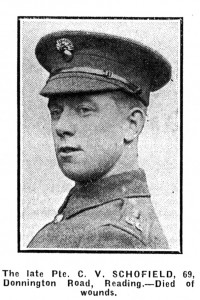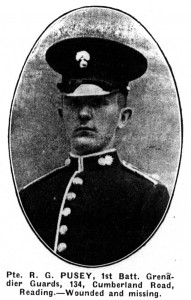Division 56
 |
In 1911 Sarah Searing was living at 101 Watlington Street, Reading. She lived with her daughter, also called Sarah(31) and her three sons Albert (27), Amos(30) and Samuel(26).
All three were labourers, Albert worked as a bricklayer’s labourer, Amos worked at the tin factory and Samuel at the biscuit factory. In 1901 the family lived at 88 Watlington Street,The County Tap, and Sarah the mother is described as the innkeeper and her daughter as barmaid.
All three men are commemorated on their mothers grave but only their initials are given. It has taken some energy to establish thier identities. Sister Sarah’s details are only given on the CWGC register for Albert and then no first name is supplied: Miss S. E. Searing, of 31, Cortis Avenue, Broadwater, Worthing. Tragically all three brother have no known graves and there commemoration in the cemetery rendered them almost invisible.
Albert Edward Searing
Private 201975
1st/4th Battalion Royal Berkshire Regiment
Albert Searing He died on 13th August 1917. The CWGC register states his age as 33. but it is believed, using census information, that he was 35. He is commemorated on the Menin Gate Memorial to the Missing, Panel 45. Strangely the war diary for the 1st/4th indicates that they were at Dambre camp and the battalion spent the day practicing for the forth coming attack which was due to begin on the 15 August. The record for the
13 August states two killed and seven wounded. There are no other details but the circumstances seem strange.
Amos Thomas Searing
Private 33662
2nd Battalion Royal Berkshire Regiment
Amos Searing died on 2nd April 1918. Born about 1881 he was thought to be about 37 on his death. He is commemorated on the Pozieres Memorial to the Missing, Panel 56 & 57.
Samuel Searing
Private202225
2nd/4th Battalion Royal Berkshire Regiment
Samuel Searing He died on 22nd August 1917 it is thought that he was about 32. He is commemorated on the Tyne Cot Memorial to the Missing, Panel 105, 106 and 162.

